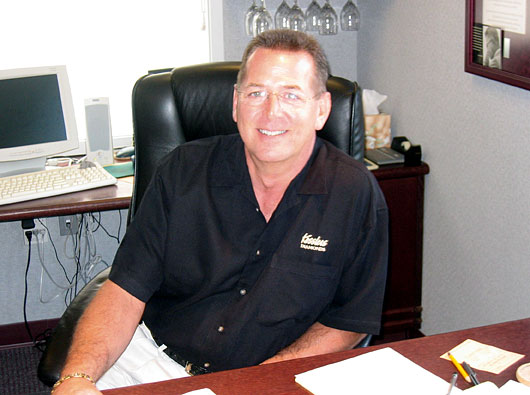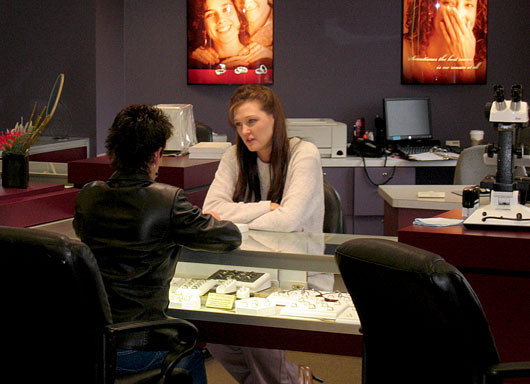Kesslers Diamonds
Address: N82 W15340 Appleton Avenue, Menomonee Falls, WI 53051 / Phone: (262) 251-4570 / URL: kesslersdiamonds.com
IN EARLY 1997, Kesslers Diamonds faced a problem. With two stores performing strongly and plans for a third on the drawing board it urgently needed to add staff. But the kind of people it wanted to attract were proving impossible to find.
Up until that point, Kesslers had been able to rely on the industry contacts of its managers to recruit people they believed would fit the company’s ethos — and its advertising promise — of putting the customer first and the transaction second.

Richard Kessler came up with a creative solution to local shortages of qualified staff.
THE IDEA
Kessler University
But now, staring at an empty talent pool, owner Richard Kessler and Vice President Bill Aberman knew they needed do something bold. Aberman’s solution was “Kessler University” — an intense inhouse training program that would allow the company to mint its own sales people.
The investment in time, money and effort that followed has paid off handsomely. Over the last 10 years, Kesslers has grown to become Wisconsin’s largest seller of diamonds with sales expected to top $22 million this year. Its five stores have a total staff of 83 who average a closing rate in excess of 50%. Perhaps most impressive in an industry wrought by high turnover is Kesslers’ staff retention rate — over 95%.
“We are long-term thinkers, and when we get it right, which is most of the time, people tend to stay a long time. Most of our people have no intention of going anywhere else,” says Aberman.
THE EXECUTION
Two Months of Rigorous Training
The training Aberman put in place is rigorous. No new sales associate is allowed onto the sales floor until he or she has spent one month in the classroom and then another month being mentored by teammates.
The initial classroom training, carried out at a dedicated centre in the Menomonee Falls store, is broken down into three sections: learning the Kessler culture, product knowledge and sales training.
“It’s is pretty intense, we learned for eight hours a day, five days a week in a classroom setting for a month before we found out which store we would call home,” recalls sales associate Jessica Costello, who has been at the store a little over a year. “It was a lot to digest.”
The culture training is particularly comprehensive — eight days of studying the store’s guiding ideas and core values. Almost half that time and much homework are devoted to Stephen Covey’s Seven Habits of Highly Effective People, which serves as a central text for the course. Covey tenets such as “Seek First to Understand, Then to Be Understood,” which emphasizes empathetic listening, and “Think win/win” (Habit Four), are a close fit with Kesslers’ way of doing business, says Aberman.
Much of the classroom training is designed to build bonds and forge an emphasis on teamwork, he says. “We ask people for their personal stories. They share things with their classmates that they haven’t shared with people who are close to them and the result is that they really bond.”
Teamwork is a key part of working at Kesslers, second only to the clients’ needs, says Aberman. “People who don’t ‘fit on the bus’ are let go,” he says.
“Some salespeople are too me-oriented for us. Here, it’s the client first, the team second, and then (the salesperson’s) needs.” Many of the trainees are new to jewelry, so the training starts with the very basics: what is an alloy, what is a mounting, what the store’s daily procedure involves.
If there is a recurring theme throughout the sales-coaching sessions it is: You’re not here to sell, you’re here to help people buy.
“Help is truly the operative word, because our focus is to help our clients buy, not to sell them something,” explains Aberman. The idea they won’t be involved in hard selling is something the trainees relish, he says.
Once the four weeks in the classroom are over, mentoring begins. Kesslers uses a team approach as opposed to a buddy system in the belief that different members of the team are strong in different aspects of the sales art. Also, some members of the team may have certain skills, such as presenting, but are not particularly effective in teaching them.
“For example, presenting diamonds is a skill new people have to develop. We have thousands of loose diamonds and semi-mounts and the temptation is for the new person to bring out five boxes, everything, and ask the client to choose, whereas an experienced sales person will bring out two to three diamonds and the person is in love with it. You need to know what to choose and why. The magic is in how you listen.”
The trainee will shadow a presentation expert as he or she goes through the routine.
Before entertaining thoughts of big closes, there is mundane work to be learned. Costello says she was given jobs like cleaning clients’ jewelry and case pieces to familiarize herself with the basics of the trade and the jewelry itself.

Once the training was complete, she felt she was fully prepared.
“When I was finally ready to start handling clients on my own I was excited and confident in my basic knowledge of the industry. (But) I was also aware that some things would have to come with time.”
Aberman says some trainees have taken the better part of a year to “ramp up” and the store is willing to indulge them; some of the slowest learners have later turned out to be the best salespeople.
At the same time, it’s important to the other team members that the new hire get up to speed quickly — the sales associates at Kesslers don’t split commissions so botching an absent colleague’s sale isn’t going to be well received.
Aberman says he’s convinced that the key to employee longevity — and its corresponding effect on the bottom line — is to reduce the risk of a mismatch before making an offer.
s such, the company spends an enormous amount of time probing who the job candidate is as an individual. The potential recruit will be interviewed five of six times, starting with the person who accepts the application up to senior management.
“It’s not about his personality but his values. They have to find fulfillment in people, be willing to go the extra mile, to understand customer service,” says Aberman.
“We hire people we think are ‘people people’ to begin with.”
Perhaps surprisingly, few have a jewelry background. The last two trainee classes were typical. Two of the participants came from the medical profession, two others from financial services — one a salesman and one an administrative assistant, another was a former client who had been working for a lawn-service company, a woman who had worked for an Internet auto-parts company, and a woman who had run a property business. Costello said she tended a bar in Milwaukee before joining.
“It’s more important that we hire staff who are good ‘people persons’, those who know how to care for the customer. These are the core values we look for. Teaching them about gems and jewelry is the easy part. But we can’t teach them what their parents should have taught them,” Aberman says.
He adds that the company does sometimes get it wrong and the costs aren’t inconsiderable because they give the candidates many months to prove themselves.
THE REWARDS
Increased Skills and Loyalty
Another threat, poaching, has been minimal because of the loyalty of staff — only one sales person has left to join another jewelry store, and it was because she had design ambitions.
Several years ago, Aberman says, a mall jeweler did come into the Appleton store with the hope of luring away some staff. But he was so impressed with the service that he called up two days later to ask for a job himself, Aberman says. Kesslers didn’t have a position for him.
Costello, a passionate advocate of the Kesslers culture, says the benefits of the training extend beyond the confines of the store.
“They really encourage us to grow both personally and professionally. It is definitely a family atmosphere and I know that being around the people here and living with the values that Kesslers tries to uphold has helped me tremendously. I love this company!”